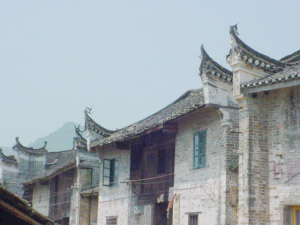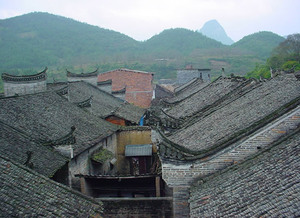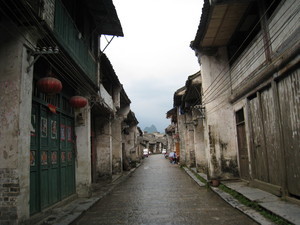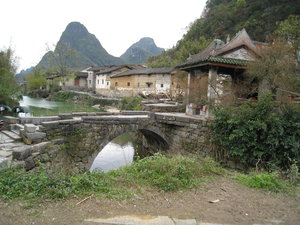Ancient Village Tours

Liugong village
Twenty kilometers south of Yangshuo, Liugong village is nestled among the unique karst mountains and faces the Li River. This ancient village has over 500 years of history and is noted for its many well-preserved buildings of traditional architectural style.
The main scenic spots are the Three-Colors Ponds, Buddha Temple, Water-Flowing Cave, and Old Pavilion. Many walking paths link the village to nearby rice paddies.
Liugong can be reached from Yangshuo in several different ways. Many people enjoy taking a bike, motorized rickshaw, or car, stopping along the way for photo shoots.
You may also ride on a motorized bamboo raft from Yangshuo to Liugong. This section of the river has relatively few tourist boats. The water is very smooth and clear. You will feel so relaxed as you float slowly downriver, and the landscape is amazing.
A third option is to travel by kayak, enjoying the nice views and stopping for a meal in a farmhouse.

Jiuxian village
Jiuxian is a typical ancient village located around 500 meters from the Yulong river and 6 km from Yangshuo. Jiuxian was formerly the Yangshuo county seat. It was built in the Tang Dynasty and has 1400 years of history. This village not only preserves Ming and Qing period architecture but also retains many old cultural traditions.
There are several paths you can take by bike or car from Yangshuo through Jiuxian to Dragon Bridge, stopping there to enjoy a local meal and soak up the colorful culture and history. It's a great place to visit!
Langzi Village
Langzi village is about 20 km from Yangshuo county. This is another typical ancient village full of very well-preserved Ming Dynasty buildings. The old quarter occupies more than 12000 square meters and includes a gun batteries.
The main attraction in the village is the Rui Zhi family hall, which boasts many different kinds of wood carving and fineness characters on the wall and ceiling. Many of the beams are carved and painted with many lifelike pictures. It has long been famous as a "unique old building."
Because few tourists no of this village, the local traditional culture and history have been preserved here much better than in the more frequently visited areas. The landscape on the way is fantastic, and the village is highly representative of southern China's old architecture.
Fuli Town
Fuli is an ancient and quiet town, 8 kilometers east of Yangshuo County. It has more than 1000 years history.
Fuli is a town with two faces. One side is the new town which is on the main road. The other side is the old town which is on the bank of the Li River. The old town retains its old buildings: wandering through the streets you can see the simple lives of the local people and experience the traditional culture. Fuli also has a market day, which is held on the 2nd, 5th,and 8th days of the traditional ten-day week.
Travel to Fuli by bicycle or boat to enjoy the amazing scenery and local lifestyle.
Fuli is famous for scroll paintings and Chinese fans with beautiful landscapes. You can watch painting on scrolls and fans and perhaps purchase a few to take home.

Xingping
Xingping
Xingping is a small and old town with more than 1,300 years of history. It is located on the east bank of the Li River, 15 miles (25 kilometers) away from Yangshuo. This town is divided into two parts: one is the new street, the other one is the old street with Ming Dynasty buildings dating from more than 500 years ago.
Xingping is well known for its fantastic landscape. The trip from Yangshuo to Xingping is also the most beautiful section of the Li River. You can take a boat or a hiking tour to enjoy this magnificent scenery and experience local people's life.

Huangyao Ancient Town
Huangyao Ancient Town is located in the northeast of Zhaoping County, Hezhou City, about 200 kilometers from Guilin. It has a history of more than 1,000 years. It emerged during the Song Dynasty (960-1279), was built up during the Wanli Period (1573-1619) of the Ming Dynasty, and prospered during the reign of the Qing emperor Qianlong (1735-1796). The Huang and Yao families dominate the town, so it is named Huangyao Town.
Covering an area of 3.6 square km, the town's architecture is in the southern style displaying a beautiful, simple pattern of blue bricks and blue tiles. The layout of the town is an array of the "nine-palaces and eight-diagrams."
This town is famous for its own karst mountains, bridges, temples, ancestor halls, and pavilions.
 More than 30 temples, ancestor halls, and pavilions are well preserved. The town also boasts numerous Chinese cultural relics that enrich the history of the town, including the calligraphy of Hangyu, great scholar of the Ming Daynasty, Hexiangning and Gao shiqi's residential houses and many other inscribed boards, couplets and steles.
More than 30 temples, ancestor halls, and pavilions are well preserved. The town also boasts numerous Chinese cultural relics that enrich the history of the town, including the calligraphy of Hangyu, great scholar of the Ming Daynasty, Hexiangning and Gao shiqi's residential houses and many other inscribed boards, couplets and steles.
